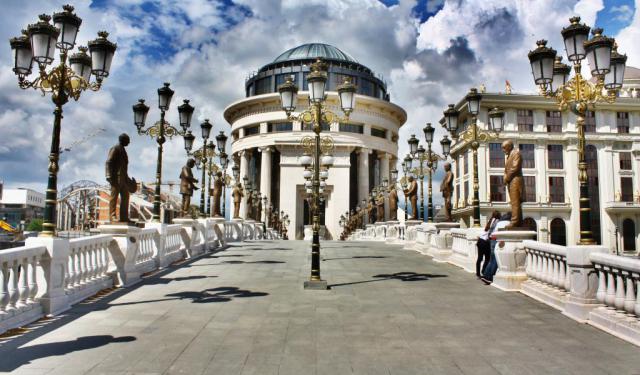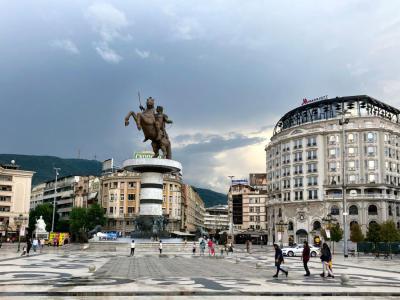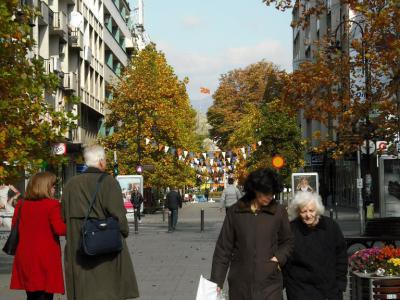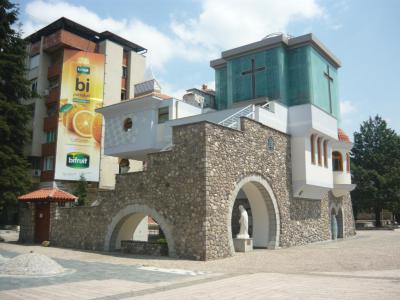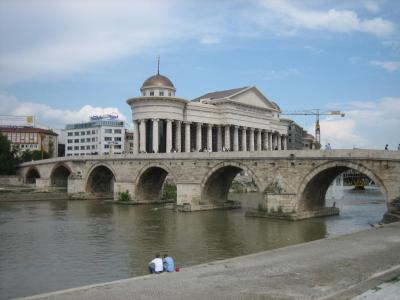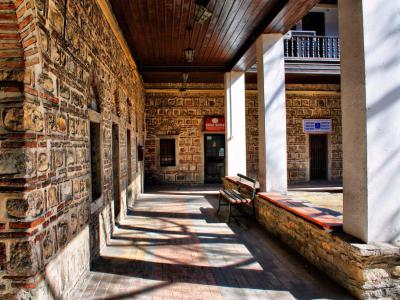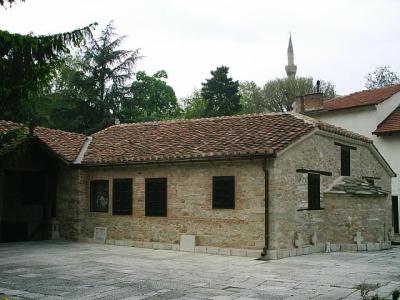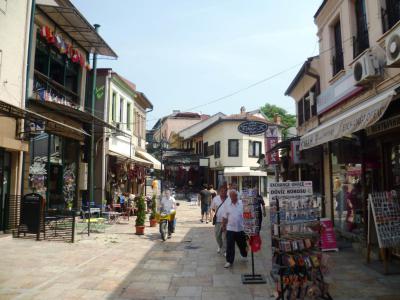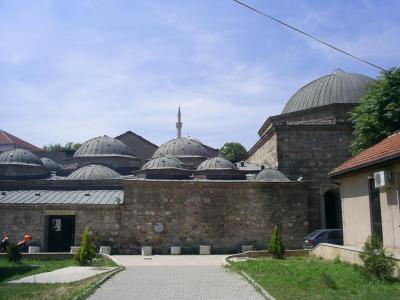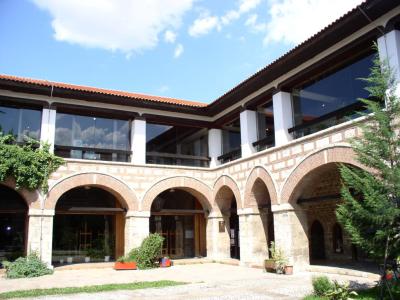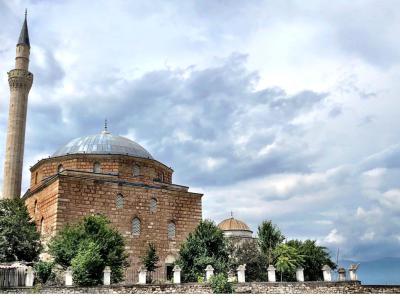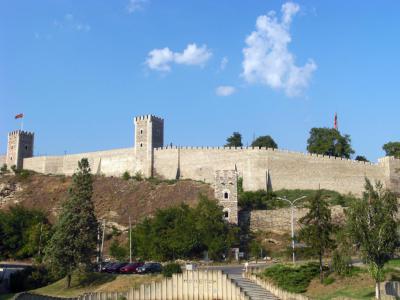Skopje Introduction Walking Tour (Self Guided), Skopje
Unlike many other Balkan capitals such as Belgrade, Sofia, and Zagreb, which only grew to importance during the 19th century, the capital of North Macedonia, Skopje, is an ancient city dating back several millennia. As such, the city has many fascinating and often contradicting cultural and historical layers detectable in everything, from the architecture to the food to the language.
The name "Skopje" itself is steeped in antiquity, tracing back to the Roman city of Scupi in the second century AD. Long before Skopje's current incarnation, the area came under Byzantine rule, witnessed conflicts between the Byzantines and the Bulgarian Empire, and eventually became part of the Serbian Empire in 1282.
In 1392, the city fell to the Ottoman Turks, who named it Uskub and held control for over 500 years. This strategic location in the Ottoman Balkans made it a hub of commerce and administration.
Over time, the city's name evolved, with "Skopje" emerging as the Slavic rendition of Scupi during the Middle Ages. In 1912, the territory was annexed by the Kingdom of Serbia, during the Balkan Wars, and the city became known as "Skoplje" in many languages. Following World War II, as a part of Yugoslavia, it was officially named "Skopje" as standard Macedonian became the official language in the territory.
In 1963, a devastating earthquake reshaped the city's landscape, prompting rapid reconstruction that included modernist architecture. While economic challenges arose during the 1980s and 1990s, the 2000s brought renewed investments, leading to the restoration of landmarks and revitalization of the city center.
At the heart of Skopje lies Macedonia Square, a bustling hub and the city's focal point, dominated by the colossal statue of Alexander the Great on horseback.
Crossing the Vardar River, you'll encounter the Stone Bridge, a symbol of Skopje's enduring connection between its past and present.
A stroll through the Old Bazaar, with its labyrinthine streets and centuries-old shops, is like stepping back in time. Here, you'll find treasures and trinkets, spices and sweets, all imbued with the essence of Skopje's history.
And of course, no visit to Skopje is complete without ascending to Kale Castle, also known as Skopje Fortress. This ancient citadel overlooks the city and offers panoramic views of the surrounding landscape.
Intrigued? The warm hospitality of Skopje beckons travelers from far and wide to embark on a journey of discovery. Come and experience the magic of Skopje yourself, savor its unique flavors, and gain a deeper insight into the beautiful and exquisitely complicated country that’s North Macedonia!
The name "Skopje" itself is steeped in antiquity, tracing back to the Roman city of Scupi in the second century AD. Long before Skopje's current incarnation, the area came under Byzantine rule, witnessed conflicts between the Byzantines and the Bulgarian Empire, and eventually became part of the Serbian Empire in 1282.
In 1392, the city fell to the Ottoman Turks, who named it Uskub and held control for over 500 years. This strategic location in the Ottoman Balkans made it a hub of commerce and administration.
Over time, the city's name evolved, with "Skopje" emerging as the Slavic rendition of Scupi during the Middle Ages. In 1912, the territory was annexed by the Kingdom of Serbia, during the Balkan Wars, and the city became known as "Skoplje" in many languages. Following World War II, as a part of Yugoslavia, it was officially named "Skopje" as standard Macedonian became the official language in the territory.
In 1963, a devastating earthquake reshaped the city's landscape, prompting rapid reconstruction that included modernist architecture. While economic challenges arose during the 1980s and 1990s, the 2000s brought renewed investments, leading to the restoration of landmarks and revitalization of the city center.
At the heart of Skopje lies Macedonia Square, a bustling hub and the city's focal point, dominated by the colossal statue of Alexander the Great on horseback.
Crossing the Vardar River, you'll encounter the Stone Bridge, a symbol of Skopje's enduring connection between its past and present.
A stroll through the Old Bazaar, with its labyrinthine streets and centuries-old shops, is like stepping back in time. Here, you'll find treasures and trinkets, spices and sweets, all imbued with the essence of Skopje's history.
And of course, no visit to Skopje is complete without ascending to Kale Castle, also known as Skopje Fortress. This ancient citadel overlooks the city and offers panoramic views of the surrounding landscape.
Intrigued? The warm hospitality of Skopje beckons travelers from far and wide to embark on a journey of discovery. Come and experience the magic of Skopje yourself, savor its unique flavors, and gain a deeper insight into the beautiful and exquisitely complicated country that’s North Macedonia!
How it works: Download the app "GPSmyCity: Walks in 1K+ Cities" from Apple App Store or Google Play Store to your mobile phone or tablet. The app turns your mobile device into a personal tour guide and its built-in GPS navigation functions guide you from one tour stop to next. The app works offline, so no data plan is needed when traveling abroad.
Skopje Introduction Walking Tour Map
Guide Name: Skopje Introduction Walking Tour
Guide Location: North Macedonia » Skopje (See other walking tours in Skopje)
Guide Type: Self-guided Walking Tour (Sightseeing)
# of Attractions: 11
Tour Duration: 2 Hour(s)
Travel Distance: 2.1 Km or 1.3 Miles
Author: DanaOffice
Sight(s) Featured in This Guide:
Guide Location: North Macedonia » Skopje (See other walking tours in Skopje)
Guide Type: Self-guided Walking Tour (Sightseeing)
# of Attractions: 11
Tour Duration: 2 Hour(s)
Travel Distance: 2.1 Km or 1.3 Miles
Author: DanaOffice
Sight(s) Featured in This Guide:
- Macedonia Square
- Macedonia Street
- Memorial House of Mother Teresa
- Stone Bridge
- Kapan Han
- Church of the Ascension of Jesus
- Old Bazaar
- Čifte Hammam
- Suli An (Watery Inn)
- Mustafa Pasha Mosque
- Kale Castle (Skopje Fortress)
1) Macedonia Square (must see)
Macedonia Squar stands as the central and most significant square in Skopje. This spacious square is the largest of its kind in the country, covering an area of approximately 18,500 square meters. Nestled in the heart of the city, it spans the Vardar River, making it a vital focal point of Skopje's urban life.
Macedonia Square is not merely a place for civic gatherings but also serves as a hub for a wide array of cultural, political, and other events. It has hosted grand Christmas festivals and remains a favorite location for significant public celebrations and gatherings.
One of the most historically pivotal moments in the square's history was the declaration of independence from Yugoslavia. On this occasion, the first president of Macedonia, Kiro Gligorov, made the momentous announcement, marking a significant turning point for the country.
Macedonia Square bears the national flag with pride. In December 2008, a prominent flagpole was erected, displaying the Macedonian flag, and this gesture was replicated in 68 other key locations across the nation.
The square is also home to several monuments and landmarks, including those dedicated to prominent figures from Macedonian history. Notably, statues of Goce Delčev and Dame Gruev were unveiled near the famous Stone Bridge on May 2, 2010. Additionally, the Centar Municipality constructed a tall monument of a Warrior on a Horse and a fountain, commemorating the 20-year anniversary of Macedonia's independence referendum from Yugoslavia. These monuments add to the historical tapestry of Macedonia Square, celebrating the nation's rich heritage.
Macedonia Square is steeped in history, as evidenced by the endurance of a feudal tower from the Middle Ages, which remarkably withstood the destructive force of the 1963 earthquake, becoming a testament to the resilience of Skopje and its cherished landmarks.
Macedonia Square is not merely a place for civic gatherings but also serves as a hub for a wide array of cultural, political, and other events. It has hosted grand Christmas festivals and remains a favorite location for significant public celebrations and gatherings.
One of the most historically pivotal moments in the square's history was the declaration of independence from Yugoslavia. On this occasion, the first president of Macedonia, Kiro Gligorov, made the momentous announcement, marking a significant turning point for the country.
Macedonia Square bears the national flag with pride. In December 2008, a prominent flagpole was erected, displaying the Macedonian flag, and this gesture was replicated in 68 other key locations across the nation.
The square is also home to several monuments and landmarks, including those dedicated to prominent figures from Macedonian history. Notably, statues of Goce Delčev and Dame Gruev were unveiled near the famous Stone Bridge on May 2, 2010. Additionally, the Centar Municipality constructed a tall monument of a Warrior on a Horse and a fountain, commemorating the 20-year anniversary of Macedonia's independence referendum from Yugoslavia. These monuments add to the historical tapestry of Macedonia Square, celebrating the nation's rich heritage.
Macedonia Square is steeped in history, as evidenced by the endurance of a feudal tower from the Middle Ages, which remarkably withstood the destructive force of the 1963 earthquake, becoming a testament to the resilience of Skopje and its cherished landmarks.
2) Macedonia Street
Macedonia Street is not just a thoroughfare; it's a vibrant avenue that encapsulates the lively essence of the city. Connecting the iconic Macedonia Square with the area housing the well-known Ramstore Mall and Skopje City Museum, this street serves as a bustling thoroughfare for locals and visitors alike.
As you traverse Macedonia Street, you'll be immersed in the dynamic rhythm of Macedonian life. The street is perpetually animated, teeming with people enjoying a leisurely stroll or engaged in various activities. The lively atmosphere is complemented by an array of establishments lining the street, offering a mix of restaurants, cafes, bars, and stores. Whether you're in the mood for a culinary adventure, a coffee break, or some retail therapy, Macedonia Street has it all.
On one side of the street, a picturesque green park invites you to unwind amidst monuments and benches. This serene oasis provides a perfect retreat after a day of bustling shopping or leisurely walks. The juxtaposition of urban vibrancy and natural tranquility creates a unique charm that defines Macedonia Street.
This street isn't just a contemporary hub; it's a testament to Skopje's rich history. With over a century of existence, Macedonia Street has witnessed the city's evolution, embodying its spirit and character. So, whether you're exploring its historical facets or simply enjoying the present-day buzz, Macedonia Street stands as a symbol of Skopje's enduring vitality.
As you traverse Macedonia Street, you'll be immersed in the dynamic rhythm of Macedonian life. The street is perpetually animated, teeming with people enjoying a leisurely stroll or engaged in various activities. The lively atmosphere is complemented by an array of establishments lining the street, offering a mix of restaurants, cafes, bars, and stores. Whether you're in the mood for a culinary adventure, a coffee break, or some retail therapy, Macedonia Street has it all.
On one side of the street, a picturesque green park invites you to unwind amidst monuments and benches. This serene oasis provides a perfect retreat after a day of bustling shopping or leisurely walks. The juxtaposition of urban vibrancy and natural tranquility creates a unique charm that defines Macedonia Street.
This street isn't just a contemporary hub; it's a testament to Skopje's rich history. With over a century of existence, Macedonia Street has witnessed the city's evolution, embodying its spirit and character. So, whether you're exploring its historical facets or simply enjoying the present-day buzz, Macedonia Street stands as a symbol of Skopje's enduring vitality.
3) Memorial House of Mother Teresa
The Mother Teresa Memorial House stands as a dedicated tribute to the Catholic saint and Nobel Peace Prize laureate, Mother Teresa. This remarkable memorial is situated in her hometown of Skopje, where she resided from 1910 to 1928.
The Mother Teresa Memorial House occupies a prominent location on Macedonia Street. This site holds significant historical and spiritual importance, as it once was home to the Sacred Heart of Jesus Roman Catholic Church, where Mother Teresa received her baptism.
The construction of this iconic memorial house, valued at two million euros, was completed, and it officially opened its doors on January 30, 2009. The inauguration ceremony was attended by a multitude of foreign delegations and dignitaries, as well as representatives from the Roman Catholic Church in North Macedonia and the Macedonian Orthodox Church. Macedonian Prime Minister Nikola Gruevski presided over the opening, marking the significance of the occasion.
The house offers a contemporary interpretation of Mother Teresa's birthplace, combining a multifunctional design with a sacred ambiance.
Inside the Mother Teresa Memorial House, precious relics connected to her life and work are carefully preserved. These relics were brought to Skopje with the assistance of the Roman Catholic Church of Skopje. In addition to the relics, the house features a museum that includes realistic sculptures portraying Mother Teresa and members of her family. One notable sculpture depicts a ten-year-old Mother Teresa, seated on a stone and tenderly cradling a pigeon in her hands, a symbol of her lifelong dedication to compassion and peace.
The Mother Teresa Memorial House also serves as a cultural center, hosting various exhibits and galleries. It stands as a lasting tribute to a remarkable humanitarian, providing visitors with an opportunity to delve into the life and legacy of this beloved figure and to experience the profound impact of her work.
The Mother Teresa Memorial House occupies a prominent location on Macedonia Street. This site holds significant historical and spiritual importance, as it once was home to the Sacred Heart of Jesus Roman Catholic Church, where Mother Teresa received her baptism.
The construction of this iconic memorial house, valued at two million euros, was completed, and it officially opened its doors on January 30, 2009. The inauguration ceremony was attended by a multitude of foreign delegations and dignitaries, as well as representatives from the Roman Catholic Church in North Macedonia and the Macedonian Orthodox Church. Macedonian Prime Minister Nikola Gruevski presided over the opening, marking the significance of the occasion.
The house offers a contemporary interpretation of Mother Teresa's birthplace, combining a multifunctional design with a sacred ambiance.
Inside the Mother Teresa Memorial House, precious relics connected to her life and work are carefully preserved. These relics were brought to Skopje with the assistance of the Roman Catholic Church of Skopje. In addition to the relics, the house features a museum that includes realistic sculptures portraying Mother Teresa and members of her family. One notable sculpture depicts a ten-year-old Mother Teresa, seated on a stone and tenderly cradling a pigeon in her hands, a symbol of her lifelong dedication to compassion and peace.
The Mother Teresa Memorial House also serves as a cultural center, hosting various exhibits and galleries. It stands as a lasting tribute to a remarkable humanitarian, providing visitors with an opportunity to delve into the life and legacy of this beloved figure and to experience the profound impact of her work.
4) Stone Bridge (must see)
The Stone Bridge spans the Vardar River. It was constructed by Sultan Mehmed the Conqueror and is sometimes referred to as the Dušan Bridge, in honor of Stefan Dušan, the Emperor of Serbia.
This magnificent bridge holds a special place in Skopje's identity and is considered one of the city's most symbolic landmarks. In fact, it plays a central role in the city's coat of arms and is prominently featured on the city's flag. The Stone Bridge serves as a vital link connecting Macedonia Square to the Old Bazaar, thus bridging the divide between two distinct parts of the city.
The bridge is a true architectural marvel, constructed with solid stone blocks and supported by robust columns connected by 12 semicircular arches. Over the centuries, it has undergone various phases of damage and repair, reflecting the bridge's resilience and historical importance. It faced significant damage during the great earthquake of 1555, which heavily impacted four of its pillars. However, renovations were swiftly carried out the same year to restore the bridge to its former glory.
The Stone Bridge is not just a testament to Skopje's architectural heritage; it has also played a role in historical events. One such event was the execution of Karposh, a historical figure, on the bridge in 1689.
In modern times, the Stone Bridge has come to symbolize the contrasts and divisions within Skopje. It serves as a physical and metaphorical boundary, separating parts of the city that have different characteristics, such as "Ottoman" or "modern," "historic" or "socialist," and "Albanian" or "Macedonian." The bridge essentially links two distinct aspects of Skopje's identity, reflecting the city's complex history and diverse population.
This magnificent bridge holds a special place in Skopje's identity and is considered one of the city's most symbolic landmarks. In fact, it plays a central role in the city's coat of arms and is prominently featured on the city's flag. The Stone Bridge serves as a vital link connecting Macedonia Square to the Old Bazaar, thus bridging the divide between two distinct parts of the city.
The bridge is a true architectural marvel, constructed with solid stone blocks and supported by robust columns connected by 12 semicircular arches. Over the centuries, it has undergone various phases of damage and repair, reflecting the bridge's resilience and historical importance. It faced significant damage during the great earthquake of 1555, which heavily impacted four of its pillars. However, renovations were swiftly carried out the same year to restore the bridge to its former glory.
The Stone Bridge is not just a testament to Skopje's architectural heritage; it has also played a role in historical events. One such event was the execution of Karposh, a historical figure, on the bridge in 1689.
In modern times, the Stone Bridge has come to symbolize the contrasts and divisions within Skopje. It serves as a physical and metaphorical boundary, separating parts of the city that have different characteristics, such as "Ottoman" or "modern," "historic" or "socialist," and "Albanian" or "Macedonian." The bridge essentially links two distinct aspects of Skopje's identity, reflecting the city's complex history and diverse population.
5) Kapan Han
Kapan Han (or, Kapan An) is a historic caravanserai located in the Old Bazaar. This architectural gem has a fascinating history dating back to the mid-15th century and is a testament to the region's rich cultural heritage.
Kapan Han was commissioned and constructed by Isa-Beg Isaković, a Bosnian general who held authority over Skopsko Krajište during this period. The primary motive behind building this caravanserai was to establish a consistent source of income for his endowment, known as a "vakuf." These endowments were charitable trusts that supported various philanthropic and religious causes. The revenue generated from Kapan Han played a crucial role in sustaining these endeavors.
The name "Kapan Han" finds its origins in the Arabic word "kabban," which was used to describe a device employed for measuring the weight of goods that were being sold at the entrance of the han. This etymology reflects the historical context of this vibrant marketplace and its importance in the economic life of Skopje.
Kapan Han boasts a substantial surface area, covering approximately 1,086 square meters. The building was thoughtfully designed to accommodate the needs of travelers, traders, and their caravans. It features two entrances, one at the ground level and another at the second level, allowing for convenient access. The han consists of a total of 44 rooms that served as accommodations for guests and traders. These rooms provided a welcoming respite for travelers and a secure space for their goods. In addition, there were facilities to house horses, situated on the east side of the han, recognizing the essential role these animals played in the transportation of goods during that time.
The neighborhood that envelops Kapan Han was referred to as "Kapan." This bustling district was intimately connected to the caravanserai and reflects the vibrant life and commerce that flourished around this historic site.
Today, part of Kapan An is a restaurant.
Kapan Han was commissioned and constructed by Isa-Beg Isaković, a Bosnian general who held authority over Skopsko Krajište during this period. The primary motive behind building this caravanserai was to establish a consistent source of income for his endowment, known as a "vakuf." These endowments were charitable trusts that supported various philanthropic and religious causes. The revenue generated from Kapan Han played a crucial role in sustaining these endeavors.
The name "Kapan Han" finds its origins in the Arabic word "kabban," which was used to describe a device employed for measuring the weight of goods that were being sold at the entrance of the han. This etymology reflects the historical context of this vibrant marketplace and its importance in the economic life of Skopje.
Kapan Han boasts a substantial surface area, covering approximately 1,086 square meters. The building was thoughtfully designed to accommodate the needs of travelers, traders, and their caravans. It features two entrances, one at the ground level and another at the second level, allowing for convenient access. The han consists of a total of 44 rooms that served as accommodations for guests and traders. These rooms provided a welcoming respite for travelers and a secure space for their goods. In addition, there were facilities to house horses, situated on the east side of the han, recognizing the essential role these animals played in the transportation of goods during that time.
The neighborhood that envelops Kapan Han was referred to as "Kapan." This bustling district was intimately connected to the caravanserai and reflects the vibrant life and commerce that flourished around this historic site.
Today, part of Kapan An is a restaurant.
6) Church of the Ascension of Jesus
The Church of the Ascension of Jesus stands as an emblem of Eastern Orthodox heritage in Skopje. Constructed in the mid-16th century, this three-nave church is characterized by a central vessel with arched ceilings and flat pages covered with domes. A women's gallery adorns the west, contributing to the church's architectural symmetry.
During the 19th century, the church underwent significant modifications, finalizing its distinctive appearance. In 1824, the construction of the iconostasis reached completion, and additional enhancements, including throne icons, were added in 1867. Skilled artisans from Skopje, including cooperatives and traders, played crucial roles in crafting the iconostasis and icons.
The church's historical journey intersects with the complex dynamics of religious affiliations. Under Ottoman rule, the Eastern Orthodox congregation fell under a Greek-dominated community. However, with the surge of nationalism, the local Slavic population voted in 1874 to join the Bulgarian Exarchate, a decision that endured until 1890 when it returned to Greek control. In 1901, the church became the seat of the Skopje Metropolitan, starting with Firmilijan and his successors.
The entrance to the churchyard is marked by a robust oak door, while within the premises, a white sarcophagus holds the remains of the revolutionary Gotse Delchev, adding a layer of historical significance to this sacred site.
During the 19th century, the church underwent significant modifications, finalizing its distinctive appearance. In 1824, the construction of the iconostasis reached completion, and additional enhancements, including throne icons, were added in 1867. Skilled artisans from Skopje, including cooperatives and traders, played crucial roles in crafting the iconostasis and icons.
The church's historical journey intersects with the complex dynamics of religious affiliations. Under Ottoman rule, the Eastern Orthodox congregation fell under a Greek-dominated community. However, with the surge of nationalism, the local Slavic population voted in 1874 to join the Bulgarian Exarchate, a decision that endured until 1890 when it returned to Greek control. In 1901, the church became the seat of the Skopje Metropolitan, starting with Firmilijan and his successors.
The entrance to the churchyard is marked by a robust oak door, while within the premises, a white sarcophagus holds the remains of the revolutionary Gotse Delchev, adding a layer of historical significance to this sacred site.
7) Old Bazaar (must see)
Skopje's Old Town, often referred to as the Old Bazaar, is a historic gem located on the opposite side of the Vardar River. It stands as a testament to the rich and diverse history of the region and is considered the second-largest bazaar in Europe after Istanbul.
The roots of the Old Bazaar date back to the 12th century when it emerged as a merchant quarter. During the period of Ottoman rule in Skopje, the Old Bazaar flourished and rapidly developed into the city's primary center of commerce. The Ottoman influence is prominently displayed through around thirty mosques, numerous caravanserais, hans (inns), and other significant buildings and monuments that dot the landscape. The bazaar has endured various challenges, including the devastating earthquake of 1555, the burning of the city in 1689, another earthquake in 1963, as well as damage during the First and Second World Wars. Despite these hardships, the Old Bazaar has faced numerous rebuildings and remained a resilient symbol of Skopje's history.
The Old Bazaar is not only an essential marketplace but also a repository of cultural and historical significance. While Ottoman architecture predominantly characterizes the area, traces of Byzantine architectural elements can also be discerned. Recent reconstruction efforts have introduced modern architectural elements, creating a unique blend of styles.
Amidst the bustling marketplace, visitors can explore the remains of roughly thirty mosques, türbes (mausoleums), two churches, and a clocktower. These architectural wonders, together with the Museum of the Republic of North Macedonia and the Museum of Modern Art, form the core of the modern bazaar.
In recent years, there has been a growing interest in promoting the Old Bazaar as a prominent tourist attraction. The Macedonian Parliament recognized the Old Bazaar as cultural heritage of particular importance, passing a law in 2008 to ensure its permanent protection. A government-led project for the revitalization of the Old Bazaar was initiated in 2010, with a focus on restoring key structures and furthering the area's economic and cultural development. This initiative aims to preserve and celebrate the historical and cultural significance of Skopje's Old Town, inviting visitors to explore its rich heritage.
The roots of the Old Bazaar date back to the 12th century when it emerged as a merchant quarter. During the period of Ottoman rule in Skopje, the Old Bazaar flourished and rapidly developed into the city's primary center of commerce. The Ottoman influence is prominently displayed through around thirty mosques, numerous caravanserais, hans (inns), and other significant buildings and monuments that dot the landscape. The bazaar has endured various challenges, including the devastating earthquake of 1555, the burning of the city in 1689, another earthquake in 1963, as well as damage during the First and Second World Wars. Despite these hardships, the Old Bazaar has faced numerous rebuildings and remained a resilient symbol of Skopje's history.
The Old Bazaar is not only an essential marketplace but also a repository of cultural and historical significance. While Ottoman architecture predominantly characterizes the area, traces of Byzantine architectural elements can also be discerned. Recent reconstruction efforts have introduced modern architectural elements, creating a unique blend of styles.
Amidst the bustling marketplace, visitors can explore the remains of roughly thirty mosques, türbes (mausoleums), two churches, and a clocktower. These architectural wonders, together with the Museum of the Republic of North Macedonia and the Museum of Modern Art, form the core of the modern bazaar.
In recent years, there has been a growing interest in promoting the Old Bazaar as a prominent tourist attraction. The Macedonian Parliament recognized the Old Bazaar as cultural heritage of particular importance, passing a law in 2008 to ensure its permanent protection. A government-led project for the revitalization of the Old Bazaar was initiated in 2010, with a focus on restoring key structures and furthering the area's economic and cultural development. This initiative aims to preserve and celebrate the historical and cultural significance of Skopje's Old Town, inviting visitors to explore its rich heritage.
8) Čifte Hammam
Čifte Hammam, dating back to the mid-15th century, stands as a testament to the region's rich cultural heritage and has undergone various transformations throughout its history.
Čifte Hammam was commissioned and constructed by Isa-Beg Ishaković, a Bosnian general. The primary objective of building this hammam was to establish a consistent source of income for his endowment. Much like other vakufs (charitable trusts) of the time, the revenue generated from this facility played a crucial role in supporting philanthropic and religious causes.
The name "Čifte Hammam" is derived from the Turkish word "çift," meaning "two" or "couple," and appropriately so, as the building comprises two main sections. This architectural design allowed for the segregation of male and female bathers, emphasizing the importance of privacy and modesty.
The hammam features separate dressing rooms for men and women, with a communal bath area in between. Within this facility, there were three distinct rooms with elevated temperatures, each serving its unique purpose. Notably, one of these rooms included a pool designed for the ritual bathing of Skopje's Jewish community.
In more recent times, since 2001, Čifte Hammam has been repurposed as an exhibition space as part of the National Institution "National Gallery of Macedonia." It plays an integral role in the city's cultural life by hosting various exhibitions that highlight both traditional and contemporary artistic expressions.
Čifte Hammam was commissioned and constructed by Isa-Beg Ishaković, a Bosnian general. The primary objective of building this hammam was to establish a consistent source of income for his endowment. Much like other vakufs (charitable trusts) of the time, the revenue generated from this facility played a crucial role in supporting philanthropic and religious causes.
The name "Čifte Hammam" is derived from the Turkish word "çift," meaning "two" or "couple," and appropriately so, as the building comprises two main sections. This architectural design allowed for the segregation of male and female bathers, emphasizing the importance of privacy and modesty.
The hammam features separate dressing rooms for men and women, with a communal bath area in between. Within this facility, there were three distinct rooms with elevated temperatures, each serving its unique purpose. Notably, one of these rooms included a pool designed for the ritual bathing of Skopje's Jewish community.
In more recent times, since 2001, Čifte Hammam has been repurposed as an exhibition space as part of the National Institution "National Gallery of Macedonia." It plays an integral role in the city's cultural life by hosting various exhibitions that highlight both traditional and contemporary artistic expressions.
9) Suli An (Watery Inn)
Suli An is a historical han, or inn, that offers a glimpse into the rich heritage of the region and its enduring architectural beauty.
Suli An, which translates to "watery inn," was constructed during the first half of the 15th century. Its intriguing name is derived from its proximity to a small river that once flowed nearby. This charming structure comprises two levels, characterized by massive walls and arches that exemplify the architectural style of the time.
The ground floor of Suli An was primarily used for the storage of goods, serving as a hub of commerce and trade. On the other hand, the rooms on the first floor were designed to accommodate overnight traders and travelers who passed through the region. This dual-purpose design was typical for hans during that era.
Suli An has faced several challenges throughout its history. In 1689, it fell victim to a devastating fire, causing significant damage. Then, in 1963, a powerful earthquake shook the region, resulting in the near-total destruction of the building. Despite these adversities, Suli An remained a testament to the resilience of historical architecture.
In 1972, a remarkable effort was made to reconstruct Suli An, preserving its historical significance. Today, it serves as the location of the Museum of the Old Bazaar, offering visitors a captivating journey through the heritage of the region. Additionally, the Faculty of Arts-Skopje has also found its place within these walls, representing a fusion of history and modern education.
Suli An, which translates to "watery inn," was constructed during the first half of the 15th century. Its intriguing name is derived from its proximity to a small river that once flowed nearby. This charming structure comprises two levels, characterized by massive walls and arches that exemplify the architectural style of the time.
The ground floor of Suli An was primarily used for the storage of goods, serving as a hub of commerce and trade. On the other hand, the rooms on the first floor were designed to accommodate overnight traders and travelers who passed through the region. This dual-purpose design was typical for hans during that era.
Suli An has faced several challenges throughout its history. In 1689, it fell victim to a devastating fire, causing significant damage. Then, in 1963, a powerful earthquake shook the region, resulting in the near-total destruction of the building. Despite these adversities, Suli An remained a testament to the resilience of historical architecture.
In 1972, a remarkable effort was made to reconstruct Suli An, preserving its historical significance. Today, it serves as the location of the Museum of the Old Bazaar, offering visitors a captivating journey through the heritage of the region. Additionally, the Faculty of Arts-Skopje has also found its place within these walls, representing a fusion of history and modern education.
10) Mustafa Pasha Mosque
Mustafa Pasha Mosque is a well-preserved Ottoman-era mosque. Constructed in 1492 by Çoban Mustafa Pasha, who later served as the vizier on the court of Sultan Selim I (1512-1520), the mosque stands proudly on a plateau above the old bazaar.
Noteworthy for its historical significance, the mosque has remained largely intact since its original construction, with no significant additions made over the years. The türbe (tomb) adjacent to the mosque serves as the final resting place for Umi, the daughter of Mustafa Pasha. Surrounding the mosque, a rose garden adds to the serene ambiance of the site.
In August 2011, the mosque underwent a comprehensive five-year renovation, generously funded by the Turkish government. This restoration work aimed to preserve and maintain the architectural and cultural heritage of the Mustafa Pasha Mosque, ensuring its continued significance in Skopje's historical landscape.
Noteworthy for its historical significance, the mosque has remained largely intact since its original construction, with no significant additions made over the years. The türbe (tomb) adjacent to the mosque serves as the final resting place for Umi, the daughter of Mustafa Pasha. Surrounding the mosque, a rose garden adds to the serene ambiance of the site.
In August 2011, the mosque underwent a comprehensive five-year renovation, generously funded by the Turkish government. This restoration work aimed to preserve and maintain the architectural and cultural heritage of the Mustafa Pasha Mosque, ensuring its continued significance in Skopje's historical landscape.
11) Kale Castle (Skopje Fortress) (must see)
Perched above the city, the Skopje Fortress is accessible from the Old Town and provides a unique vantage point to appreciate the city's beauty. While much of the castle is now in ruins, its towers remain, and it still affords visitors a breathtaking view from its elevated position.
The fortress holds great significance for the city, as it is prominently featured on the coat of arms of Skopje, which, in turn, is incorporated into the city's flag.
The history of the Skopje Fortress dates back to ancient times. The first fortress was constructed in the 6th century AD, on a site with a history of human habitation dating back to the Neolithic and Bronze Ages, roughly from 4000 BC onwards. It was predominantly built using yellow limestone and travertine, and it contains fragments of Latin inscriptions. Much of the material used in the construction of the fortress was sourced from the remnants of the Roman city of Skupi, which had been utterly destroyed by a powerful earthquake in 518.
The fortress is believed to have been erected during the reign of Emperor Justinian I and was subsequently expanded during the 10th and 11th centuries, using the remains of Justinian's original Byzantine fortress. It's likely that the earlier fortress suffered damage during a series of wars and battles in the region.
One of the pivotal historical events that took place at the Skopje Fortress was the coronation of Stefan Dušan, who adopted the title of Emperor in 1346 and subsequently moved the capital of the Serbian Empire to Skopje.
In 1660, the chronicler of the Ottoman Empire, Evliya Çelebi, provided a detailed account of the fortress's appearance during his travels through the empire, further emphasizing its historical significance.
Despite its rich history, the fortress suffered substantial damage from an earthquake in 1963. However, recent reconstruction efforts have aimed to restore this iconic landmark to its former glory, ensuring that it remains a place of historical and cultural importance for Skopje and its visitors.
The fortress holds great significance for the city, as it is prominently featured on the coat of arms of Skopje, which, in turn, is incorporated into the city's flag.
The history of the Skopje Fortress dates back to ancient times. The first fortress was constructed in the 6th century AD, on a site with a history of human habitation dating back to the Neolithic and Bronze Ages, roughly from 4000 BC onwards. It was predominantly built using yellow limestone and travertine, and it contains fragments of Latin inscriptions. Much of the material used in the construction of the fortress was sourced from the remnants of the Roman city of Skupi, which had been utterly destroyed by a powerful earthquake in 518.
The fortress is believed to have been erected during the reign of Emperor Justinian I and was subsequently expanded during the 10th and 11th centuries, using the remains of Justinian's original Byzantine fortress. It's likely that the earlier fortress suffered damage during a series of wars and battles in the region.
One of the pivotal historical events that took place at the Skopje Fortress was the coronation of Stefan Dušan, who adopted the title of Emperor in 1346 and subsequently moved the capital of the Serbian Empire to Skopje.
In 1660, the chronicler of the Ottoman Empire, Evliya Çelebi, provided a detailed account of the fortress's appearance during his travels through the empire, further emphasizing its historical significance.
Despite its rich history, the fortress suffered substantial damage from an earthquake in 1963. However, recent reconstruction efforts have aimed to restore this iconic landmark to its former glory, ensuring that it remains a place of historical and cultural importance for Skopje and its visitors.
Useful Travel Guides for Planning Your Trip
Top 12 Balkan Foods to Try in Skopje
Are you planning to go to Skopje and want to experience some of the Balkan cuisines? Here are our top 12 recommendations, depending on the month of the...
The Most Popular Cities
/ view all
